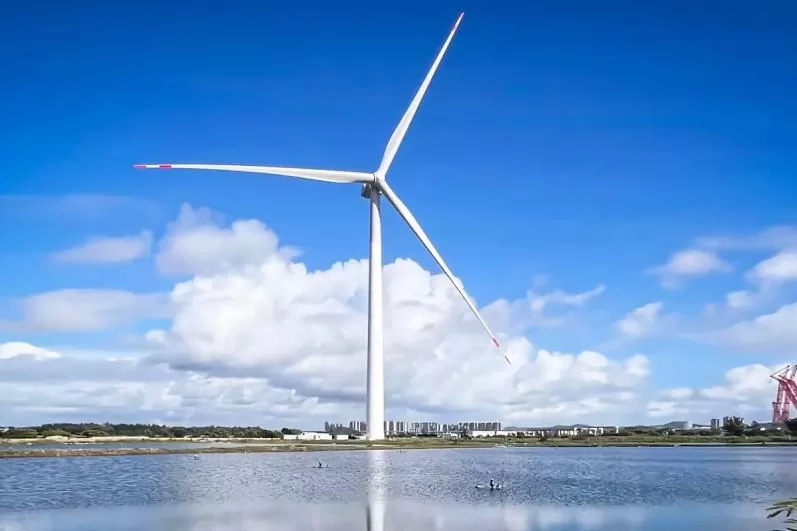Chinese manufacturer Dongfang Electric holds the current world record for the most powerful offshore wind turbine rated at 26 MW. Developed through DF Wind’s advanced platform architecture, the unit integrates a next-generation permanent-magnet direct-drive system. It also has a high-torque transmission to achieve record-level power output and energy capture. The prototype, installed at the company’s coastal test base in Fujian, is engineered for deep-water offshore conditions. It also features optimized load control, lightweight modular blades exceeding 150 meters in length, and a rotor diameter of over 300 meters.
Overview on the World’s Largest Offshore Wind Turbine
Another step taken in China’s strides to achieving net zero is the Dongfang’s 26 MW offshore wind turbine. This turbine beats Mingyang’s record breaking wind turbine in both size and capacity. The 26 MW wind turbine is now the largest in the world.
Specs for the World’s Largest Offshore Wind Turbine
The giant turbines are being build in Fuzhou, Fujian Province in China. They will stand at 340 meters and will have the center of the hub sit at a height of 185 meters. The blades have an enormous diameter of 310 m and a wide sweep area of 75,477 square meters.
These wind energy harvesters also come with special features. These include:
1. A third generation fully integrated semi-direct drive technology which features a highly integrated generator, gearbox and shafting.
When compared to previous releases that were directly connected to the power grid, the third generation technology presents with 67% increase in torque, 36% reduced turbine vibration, and a 5 % reduction in components temperature rise.
The generator, which is the devil in the detail, will largely contribute to the characteristic pure torque, high load, and high reliability of the turbine.
2. Resistance to corrosion and the ability to withstand violent typhoons with winds speeds of up to 137mph (220 km/hr).
137 mph of wind speeds are equivalent to a category 17 typhoon or those of a category 4 hurricane. The “dual anti-typhoon design” that was incorporated in the engineering of the turbines is what makes these gigantic wind harvesters able to take their ground in the face of the destructive winds.
The 26 MW turbine will be able to generate up to 100GWh of electricity in a year which can power about 55,000 homes in China.
The 26 MW Dongfang turbine vs The 20 MW Mingyang turbine
Mingyang Smart Energy announced the installation of their (now previous) world’s largest offshore wind turbines in September 2024.
Their turbines have a rotor diameter of a varying 260-292 meters, and cover a maximum sweep area of 66,966 square meters. This is a bit smaller compared to the 26 MW turbines by Dongfang Electric Corporation (DEC).
The 26 MW turbines have a power capacity of 100GWh while Mingyang’s turbines come close with only 80GWh in electricity generated in a year – this is still a lot of clean energy generated annually.
Surprisingly, the 20 MW turbines beats the 26 MW turbines in their ability to withstand violent wind storms. According to Mingyang, their turbines are able to face violent wind speeds of up to 79.8 m/s (178 mph / 287 km/hr), while the 26 MW turbines can stand unwavered to wind speeds of up to only 137 mph (220 km/hr). Mingyang is also developing the world’s largest floating offshore turbine rated at 50 MW.

Also Read: 131 Meters of Wind Power: The World’s Largest Onshore Wind Turbine
How Reliable are the 26 MW Turbines?
According to DEC, the units are specifically made to suit medium to high speed winds. They will also have low operation and maintenance costs.
The 100 GWh of electricity annually will not only power households but also reduce coal usage. This will be by up to 30,000 tons, and cut down carbon emissions by up to 80,000 tons.
End-notes
DEC has a good track record in the innovation of sustainable energy solutions over the course of the decade.
They have achievements like building the first 10 MW offshore wind turbine in Asia. This was followed by an upgrade to 13 MW. Then the world’s first 18 MW offshore wind turbines, and more innovations that broke “world records” like the world’ s first ultra high turbines and the longest blades for a wind turbine.
They now have the largest turbine, both by size and capacity, in the world. More is surely set to come in the race to harness and make use of greener, cleaner, and sustainable energy for the planet.



